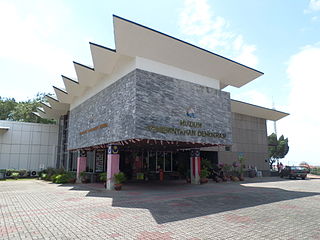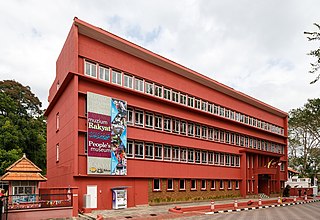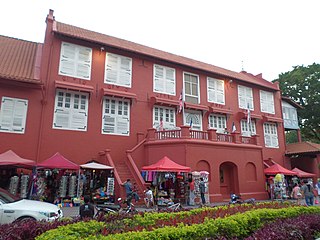
Malacca City is the capital city of the Malaysian state of Malacca, in Melaka Tengah District. It is the oldest Malaysian city on the Straits of Malacca, having become a successful entrepôt in the era of the Malacca Sultanate. The present-day city was founded by Parameswara, a Sumatran prince who escaped to the Malay Peninsula when Srivijaya fell to the Majapahit. Following the establishment of the Malacca Sultanate, the city drew the attention of traders from the Middle East, South Asia, and East Asia, as well as the Portuguese, who intended to dominate the trade route in Asia. After Malacca was conquered by Portugal, the city became an area of conflict when the sultanates of Aceh and Johor attempted to take control from the Portuguese.

Ayer Keroh is a town situated in Melaka Tengah District, Malacca, Malaysia. It is the seat of the state government since 2006, being the home of the state secretariat building complex – Seri Negeri complex and one of a few towns which formed the Hang Tuah Jaya municipality.

Melaka Tengah District is one of the three administrative districts in Malacca, Malaysia. It borders Alor Gajah District to the north and Jasin District to the east. The capital of the state, Malacca City, is located in this district. This district is the major destination of tourists in Malacca as most historical spots are situated within it.

Malacca, officially the Historic State of Malacca, is a state in Malaysia located in the southern region of the Malay Peninsula, facing the Strait of Malacca. The state is bordered by Negeri Sembilan to the north and west and Johor to the south. The exclave of Tanjung Tuan also borders Negeri Sembilan to the north. Its capital is Malacca City, which has been listed as a UNESCO World Heritage Site since 7 July 2008.

Malacca Stamp Museum is a postal museum in Malacca City, Malacca, Malaysia. It is housed in a building that was constructed using local materials and has the shape and characteristics of western architecture.

The Education Museum is a museum in Malacca City, Malacca, Malaysia, which exhibits the historical development of the state's education system from the Malacca Sultanate, British Malaya, Japanese occupation and the present time.

The Malaysia Youth Museum is a museum in Malacca City, Malacca, Malaysia, which dedicated to the youth of Malaysia and their contribution to the economic and social wellbeing at regional, national, and international levels.

The Democratic Government Museum is a museum about the development and practice of parliamentary democracy, which is located at St. Paul's Hill in Malacca City, Malacca, Malaysia. The museum was formerly the Malacca State Legislative Assembly building, which had moved to Ayer Keroh as its present location since February 2000, in which its foundation stone was laid on 13 August 1961.

People's Museum is a museum in Malacca City, Malacca, Malaysia, which records and preserves the achievements of Malacca in the development sector and officially opened on 15 April 1992 by then Prime Minister Mahathir Mohamad. It is located at the ground floor of the former Historical City of Malacca Municipal Council building, originally constructed in the 1960s and believed to be built on top of the ruins of Dutch building, which also houses the Beauty Museum and Kite Museum at the upper floors.

The Malaysia Architecture Museum is an architecture museum in Malacca City, Malacca, Malaysia which exhibits various architectural materials, building models and concepts.

Malacca Islamic Museum is a museum about Islamic culture in Malacca City, Malacca, Malaysia. It exhibits various artifacts about the replica of early Quran manuscripts, history of mosques in the state, various religious figures from the state and Malaysia etc. The museum building used to house the Islamic Council of Malacca Office before it was shifted to its current location beside the State Mosque. Before the establishment of the Islamic museum, extensive renovations were done to create space for the museum.

Malacca Literature Museum is a museum about Malaysian literary works in Malacca City, Malacca, Malaysia, which resembles the structural design of a residence and was officiated by Chief Minister Mohd Zin Abdul Ghani in 1984.

Maritime Museum is a museum about maritime activities in Malacca City, Malacca, Malaysia. It was officially opened to the public by Prime Minister Mahathir Mohamad on 13 June 1994, began with phase one. The phase two of the museum is housed in the old Guthrie building and was opened by State Committee for Tourism, Culture and Environment Chairman Poh Ah Tiam on 23 May 1998.

Kite Museum is a museum about kites in Malacca City, Malacca, Malaysia, which was officially opened in September 1995 by Chief Minister Mohd Zin Abdul Ghani in conjunction with the Regional Malay Customs seminar. It occupies the upper floor of the former Historical City Municipal Council building, originally constructed in the 1960s and believed to be built on top of the ruins of Dutch building, which also houses the People's Museum and Beauty Museum at the ground floor and top floor respectively. The museum displays various aspects of kites, such as communication, use as weapons, sport, leisure activities, how different countries make kites, different materials to make kites, role of kites in the life of people etc. It also displays the Wau Gallery, Traditional Games, Top Spinning Gallery and Datuk Wira Haji Md Borhan bin Yaman Gallery. It opens everyday from 9.00 a.m. to 5.00 p.m.

The Governor's Museum is a museum atop St. Paul's Hill in Malacca City, Malacca, Malaysia, which exhibits the personal belongings of various governors of Malacca since the independence of Malaya. The museum's building was formerly used as the official residence and office of the Dutch governor of Malacca, as well as the official residence of the Yang di-Pertua Negeri or Governor of Malacca until September 1996, before being turned into a museum and officially opened to the public in 2002.

Straits Chinese Jewellery Museum is a museum which displays the furniture and jewellery of the Peranakan culture in Malacca City, Malacca, Malaysia. It was opened in October 2012 and housed in a heritage house building that used to be a house of a prominent Peranakan Chinese. The house consists of segments such as living room, two open-space courtyards and dining room.

The Malay and Islamic World Museum is a museum about Malay and Islamic cultures in Malacca City, Malacca, Malaysia. It is housed in the Bastion House building which was built in 1910 and occupied by the British rubber company Dunlop until 1986. The building has the English architectural elements, the rectangular shape design with deep slanted roofs. The museum displays the information about the spread of Islam in the world, important and historical Malay and Muslim figures, important Islamic buildings, artifacts, traditional dress etc.

The History and Ethnography Museum is a museum in Malacca City, Malacca, Malaysia. It is located inside the Stadthuys building, built during the Dutch Malacca administration period in 1650. The historical section of the museum displays the history of Malacca from its establishment in 1400 until 1957, the year Malaya gained independence, while the ethnography section of the museum portrays the lifestyle and culture of various communities and sub-communities of Malacca including the Malays, the Chinese, the Indians, the Portuguese, the Baba and Nyonya, the Chetti and Chitty communities. Other exhibits include items used in traditional wedding ceremonies, kitchen utensils, musical instruments and collections of ancient porcelain ware, weapons, stamps and ancient currencies.



















